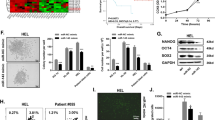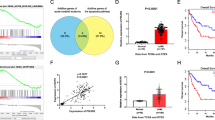Abstract
Objectives
Currently, lncRNA plays an important role in the occurrence and development of acute myeloid leukemia (AML), including SNHG5. However, the role and mechanism of SNHG5 in AML remains unclear. In this study, we explored the regulatory mechanism of SNHG5 in the development of AML.
Methods and results
QRT-PCR was used to investigate the expression of SNHG5, miR-489-3p, and SOX. The proliferation and apoptosis of AML cells were analyzed by cell transfection, cell counting kit-8 (CCK8), and flow cytometric analysis. Moreover, the expression analysis of marker proteins was detected by western blot. Through luciferase activity assay, RNA pull-down, and RNA-binding protein immunoprecipitation (RIP), we proved that SNHG5 could bind miR-489-3p and SOX4 which might be the target gene of miR-489-3p.
Results
We first found that SNHG5 was up-regulated in both AML patient bone marrow samples and various AML cell lines. Second, we found that knockdown of SNHG5 inhibited proliferation of AML cells and promoted apoptosis. It was found that SNHG5 could bind miR-489-3p, and the relative expression of SNHG5 was negatively correlated with miR-489-3p. Further results suggested that SOX4 might be the target gene of miR-489-3p. Finally, our experimental data indicated that knockdown of SNHG5 could reduce the tumor volume and down-regulated SOX4 levels in vivo.
Conclusions
Our results demonstrated that SNHG5 affected the expression of SOX4 through binding miR-489-3p to regulate proliferation and apoptosis of AML, which might act as a prospective prognostic biological marker and a promising therapeutic target for AML.







Similar content being viewed by others
Data availability
All data generated or analyzed during this study are included in this published article.
References
Houda H. Angiogenesis and acute myeloid leukemia. Hematology. 2014;19(6):311–23.
Grimwade D. The clinical significance of cytogenetic abnormalities in acute myeloid leukaemia. Best Pract Res Clin Haematol. 2001;14(3):497–529.
Omar AW, Levine RL. Mutations in epigenetic modifiers in the pathogenesis and therapy of acute myeloid leukemia. Blood. 2013;121(18):3563–72.
Alessandro I, Valentina S, Marilena C, Federica L, Giuseppe V, Sarah P, et al. The role of the immunosuppressive microenvironment in acute myeloid leukemia development and treatment. Expert Rev Hematol. 2014;7(6):807–18.
Ha PM, Cho SA, Kyung Hyun Y, Moon Hee Y, Young AJ, Hyo Soo L, et al. Gene expression profile related to prognosis of acute myeloid leukemia. Oncol Rep. 2007;18(6):1395–402.
Basturk A, Akinci S, Hacibekiroglu T, Guney T, Kutlucan A, Ceran F, et al. Prognostic significance of flow cytometry findings in Turkish adult acute leukemia patients. Eur Rev Med Pharmacol Sci. 2015;19(18):3360–6.
Yang G, Lu X, Yuan L. LncRNA: a link between RNA and cancer. Biochem Biophys Acta. 2014;1839(11):1097–109.
Gibb EA, Brown CJ, Wan LL. The functional role of long non-coding RNA in human carcinomas. Mol Cancer. 2011;10(1):38.
Fernando TR, Rodriguez-Malave NI, Waters EV, Yan W, Casero D, Basso G, et al. LncRNA expression discriminates karyotype and predicts survival in B-lymphoblastic leukemia. Mol Cancer Res. 2015;13(5):839–51.
Chen L, Wang W, Cao L, Li Z, Wang X. Long non-coding RNA CCAT1 acts as a competing endogenous RNA to regulate cell growth and differentiation in acute myeloid leukemia. Mol Cells. 2016;39(4):330–6.
He B, Bai Y, Kang W, Zhang X, Jiang X. LncRNA SNHG5 regulates imatinib resistance in chronic myeloid leukemia via acting as a CeRNA against MiR-205-5p. Am J Cancer Res. 2017;7(8):1704.
Jiang L, He D, Yang D, Chen Z, Pan Q, Mao A, et al. MiR-489 regulates chemoresistance in breast cancer via epithelial mesenchymal transition pathway. FEBS Lett. 2014;588(11):2009–155.
Xie Z, Cai L, Li R, Zheng J, Wu H, Yang X, et al. Down-regulation of miR-489 contributes into NSCLC cell invasion through targeting SUZ12. Tumour Biol. 2015;36(8):6497–505.
Zhang H, Alberich-Jorda M, Amabile G, Yang H, Staber PB, Di Ruscio A, et al. Sox4 is a key oncogenic target in C/EBPalpha mutant acute myeloid leukemia. Cancer Cell. 2013;24(5):575–88. https://doi.org/10.1016/j.ccr.2013.09.018.
Lu JW, Hsieh MS, Hou HA, Chen CY, Tien HF, Lin LI. Overexpression of SOX4 correlates with poor prognosis of acute myeloid leukemia and is leukemogenic in zebrafish. Blood Cancer J. 2017;7(8):e593. https://doi.org/10.1038/bcj.2017.74.
Fernando TR, Contreras JR, Zampini M, Rodriguez-Malave NI, Alberti MO, Anguiano J, et al. The lncRNA CASC15 regulates SOX4 expression in RUNX1-rearranged acute leukemia. Mol Cancer. 2017;16(1):126. https://doi.org/10.1186/s12943-017-0692-x.
Press OU. World Medical Association declaration of Helsinki. Gastroenterologia Japonica. 1991;26(2):269–70.
Clark JD, Gebhart GF, Gonder JC, Keeling ME, Kohn DF. The 1996 guide for thecare and use of laboratory animals. Ilar J. 1997;38(1):41–8.
Shi DB, Wang YW, Xing AY, Gao JW, Zhang H, Guo XY, et al. C/EBPα-induced miR-100 expression suppresses tumor metastasis and growth by targeting ZBTB7A in gastric cancer. Cancer Lett. 2015;369(2):376–85.
Wang X, Chen H, Bai J, He A. MicroRNA: an important regulator in acute myeloid leukemia. Cell Biol Int. 2017;41(9):936–45. https://doi.org/10.1002/cbin.10770.
Wallace JA, O'Connell RM. MicroRNAs and acute myeloid leukemia: therapeutic implications and emerging concepts. Blood. 2017;130(11):1290–301. https://doi.org/10.1182/blood-2016-10-697698.
Liao Q, Wang B, Li X, Jiang G. miRNAs in acute myeloid leukemia. Oncotarget. 2017;8(2):3666–822. https://doi.org/10.18632/oncotarget.12343.
Liu Q, Yang G, Qian Y. Loss of MicroRNA-489-3p promotes osteosarcoma metastasis by activating PAX3-MET pathway. Mol. Carcinog. 2016;56(4):1312–21.
Apostolos Z, Lambrou GI, Nikos M, Patroklos K, Gregory P, Krinio G, et al. New miRNA profiles accurately distinguish renal cell carcinomas and upper tract urothelial carcinomas from the normal kidney. PLoS ONE. 2014;9(3):e91646.
Enrico M, Luigi M, Apurva C, Masamichi H, Guido M, Matteo B, et al. Clear cell papillary renal cell carcinoma: micro-RNA expression profiling and comparison with clear cell renal cell carcinoma and papillary renal cell carcinoma. J Urol. 2014;191(4):e244-e.
Ma Z, Xue S, Zeng B, Qiu D. lncRNA SNHG5 is associated with poor prognosis of bladder cancer and promotes bladder cancer cell proliferation through targeting p27. Oncol Lett. 2018;15(2):1924–30.
Wang Z, Pan L, Yu H, Wang Y. The long non-coding RNA SNHG5 regulates gefitinib resistance in lung adenocarcinoma cells by targeting miR-377/CASP1 axis. Biosci Rep. 2018;38(4):BSR20180400.
Lu Y, Wang S, Yue L, Tognetti L, Rui T, Kang Z, et al. SNHG5 promotes proliferation and induces apoptosis in melanoma by sponging miR-155. RSC Adv. 2018;8(11):6160–8.
Zhao L, Guo H, Zhou B, Feng J, Li Y, Han T, et al. Long non-coding RNA SNHG5 suppresses gastric cancer progression by trapping MTA2 in the cytosol. Oncogene. 2016;35(44):5770.
Damas ND, Marcatti M, Côme C, Christensen LL, Nielsen MM, Baumgartner R, et al. SNHG5 promotes colorectal cancer cell survival by counteracting STAU1-mediated mRNA destabilization. Nat Commun. 2016;7:13875.
Fung TK, Leung AY, So CW. Sox4you: a new player in C/EBPalpha leukemia. Cancer Cell. 2013;24(5):557–9. https://doi.org/10.1016/j.ccr.2013.10.016.
Chen J, Ju HL, Yuan XY, Wang TJ, Lai BQ. SOX4 is a potential prognostic factor in human cancers: a systematic review and meta-analysis. Clin Transl Oncol. 2016;18(1):65–72. https://doi.org/10.1007/s12094-015-1337-4.
Sun X, Liu H, Li T, Qin L. MicroRNA3395p inhibits cell proliferation of acute myeloid leukaemia by directly targeting SOX4. Mol Med Rep. 2018;18(6):5261–9. https://doi.org/10.3892/mmr.2018.9552.
Pines J. The cell cycle kinases. Semin Cancer Biol. 1994;5(4):305–13.
John RR, Malathi N, Ravindran C, Anandan S. Mini review: Multifaceted role played by cyclin D1 in tumor behavior. Indian J Dent Res. 2017;28(2):187–92. https://doi.org/10.4103/ijdr.IJDR_697_16.
Sherr CJ, Beach D, Shapiro GI. Targeting CDK4 and CDK6: from discovery to therapy. Cancer Discov. 2016;6(4):353–67. https://doi.org/10.1158/2159-8290.cd-15-0894.
Renault TT, Dejean LM, Manon S. A brewing understanding of the regulation of Bax function by Bcl-xL and Bcl-2. Mech Ageing Dev. 2017;161(Pt B):201–10. https://doi.org/10.1016/j.mad.2016.04.007.
Edlich F. BCL-2 proteins and apoptosis: recent insights and unknowns. Biochem Biophys Res Commun. 2018;500(1):26–34. https://doi.org/10.1016/j.bbrc.2017.06.190.
Bourboulia D, Stetler-Stevenson WG. Matrix metalloproteinases (MMPs) and tissue inhibitors of metalloproteinases (TIMPs): positive and negative regulators in tumor cell adhesion. Semin Cancer Biol. 2010;20(3):161–8.
Malemud CJ. Matrix metalloproteinases (MMPs) in health and disease: an overview. Front Biosci. 2006;11(2):1696–701.
Xu KH, Lu DP. Plumbagin induces ROS-mediated apoptosis in human promyelocytic leukemia cells in vivo. Leuk Res. 2010;34(5):658–65. https://doi.org/10.1016/j.leukres.2009.08.017.
Her Z, Yong KSM, Paramasivam K, Tan WWS, Chan XY, Tan SY, et al. An improved pre-clinical patient-derived liquid xenograft mouse model for acute myeloid leukemia. J Hematol Oncol. 2017;10(1):162. https://doi.org/10.1186/s13045-017-0532-x.
Author information
Authors and Affiliations
Contributions
XYY and WGZ conceived and designed the experiments, MYF and CCW analyzed and interpreted the results of the experiments, and LH and CMY performed the experiments.
Corresponding author
Ethics declarations
Conflict of interest
The authors declare that they have no competing interests, and all authors should confirm its accuracy.
Ethics approval and consent to participate
The animal use protocol listed below has been reviewed and approved by the Animal Ethical and Welfare Committee.
Additional information
Responsible Editor: John Di Battista.
Publisher's Note
Springer Nature remains neutral with regard to jurisdictional claims in published maps and institutional affiliations.
Electronic supplementary material
Below is the link to the electronic supplementary material.

11_2020_1345_MOESM1_ESM.jpg
Figure S1 The cell cycle examined by flow cytometry about the effects of SNHG5 knockdown on cells cycle in KG-1a and HL-60 cells. Figure S2 Cells cycle detected by flow cytometry in KG-1a and HL-60 cells transfected with inh NC and si-NC, inh NC and si-SNHG5, or si-SNHG5 and miR-489-3p inh (JPG 3063 kb)
Rights and permissions
About this article
Cite this article
Ying, X., Zhang, W., Fang, M. et al. LncRNA SNHG5 regulates SOX4 expression through competitive binding to miR-489-3p in acute myeloid leukemia. Inflamm. Res. 69, 607–618 (2020). https://doi.org/10.1007/s00011-020-01345-x
Received:
Revised:
Accepted:
Published:
Issue Date:
DOI: https://doi.org/10.1007/s00011-020-01345-x




